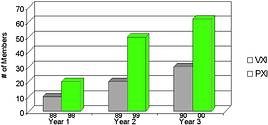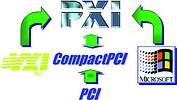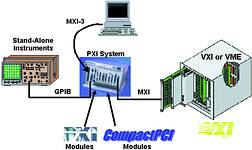
Since the announcement of the PXI specification in 1997 as an open industry standard, the number of available products and companies supporting the PXI platform has experienced phenomenal growth. Because of this growth, one can now truly unify one's enterprise around familiar PC technology by standardising on the PXI platform for test and measurement applications. In this article Rick Martin details the growth of the PXI platform, the trends for continued growth of PXI in the future, and how standardising on a PXI platform for test and measurement applications can benefit one's entire business.
A brief history of PXI
The goals of the open PXI standard were to bring several benefits to test and measurement scientists and engineers, including increased test throughput, smaller instrument and system size, reduced cost, more precise timing and synchronisation, and a standardised hardware environment for programming and configuration. Prior to the introduction of the open PXI standard in 1997, engineers and scientists had other platform options available for their test and measurement systems: the desktop PC, VXI/VME-based systems, and standalone instruments.
The desktop PC offered very good performance, followed the standard PC hardware/software model, and was very low cost. However, the PC had two very distinct limitations: a low number of available slots and the lack of a rugged, industrial package. Industrial PCs lacked the proper mechanical package to adequately cool system components or to withstand the normal shock and vibration of industrial environments.
At the other end of the price/performance spectrum was the high-end VXI (VME eXtensions for Instrumentation) platform. These systems provided better performance than the PC, but the systems were large, expensive, run on difficult to use non-standard software, and built on a 30-year-old VME bus technology.
Today, scientists and engineers have another option: PXI provides equal or better performance than VXI systems with many of the same features, such as integrated timing and triggering, but with a smaller overall footprint and at substantially lower cost. In addition, one gets the same high-speed PCI bus found in today's PCs, but in a more rugged, industrial package and with the ability to directly interface with other platforms.
PXI growth
In order to gauge how quickly PXI is becoming the industry standard platform for test and measurement, let us compare the growth of PXI to VXI, which was started in 1987 in much the same fashion.
PXI has far outperformed VXI in terms of initial acceptance within the T&M industry. Figure 1 displays the number of member companies in the standards bodies for PXI (the PXI Systems Alliance) and for VXI (the VXIbus Consortium) after their first three years of existence. As shown, the PXI Systems Alliance more than doubled the number of member companies (62 members at the end of 2000) that endorse the standard that VXI had within the same timeframe of development. For comparison, the VXIbus Consortium currently has about 80 active members.

In January of this year, the PXI Systems Alliance reported a dramatic increase in the number of products that conform to the PXI Standard. These products increased from almost 50 in mid-1999 to over 200 by the end of 2000, marking an increase of almost 400% in a 1/2-year period. Current estimates have this number now over 300, a rather large number when one considers that the open PXI specification was only introduced just four years ago. These figures now bring total products that conform to the PXI/CompactPCI specification and address the data acquisition and test market to well over 500. For comparison, approximately 1200 VXI products are available today after 14 years of existence.
Frost and Sullivan published a report on the total PXI/CompactPCI Test & Measurement Market for 1997-2005 in January 1999, showing the market size growing from $2,8m in 1997 to $16m in 1998 and forecasting a compound annual growth rate of 29,2% from 1997 to 2005 with heavy weighting in the early years. With this data, the PXI Systems Alliance estimated the overall PXI Market to be in the $35-$50m range for 2000 and expected continued growth on the order of +50% per year. Frost and Sullivan (due late this year) and Prime Data Research (due early next year) are currently working on new PXI market studies that will give us a clearer look at more recent market growth trends and estimates for the next several years.
The business benefits of PXI
Although the widespread acceptance certainly paints a compelling picture for PXI as the test and measurement platform, what makes PXI successful is the real benefits it provides you and your business.
The major strength of PXI is that it uses proven industry-standard technology (Figure 2). PXI leverages CompactPCI and adds the best features of Microsoft Windows and VXI. From Microsoft, PXI leverages the standard, ready-to-use software available in the PC market. With PXI, one uses the same familiar technology on the production floor that resides in one's office. One can develop one's application on a desktop PC and immediately port it to PXI with no software changes. In addition, the familiarity of the software eliminates the cost of training and retraining personnel every time a new system is implemented. From VXI, PXI leverages the rugged, modular, industrial packaging and the integrated timing and triggering features. A PXI system is built around a rugged architecture that has proven successful in industrial settings for many years. The modular architecture makes it easy to configure, reconfigure, and repair one's PXI systems, which results in very low mean-time-to-repair. Ultimately, one benefits as a PXI platform user with lower cost of ownership, decreased time-to-market, and increased profitability.

Just as PXI leverages other standards, other instrumentation architectures can leverage PXI technology (Figure 3). With readily available interface modules, a PXI system can be used as the main controller for VXI, VME, and GPIB systems. MXI-3 technology provides direct PC control of PXI/CompactPCI systems. In addition, PXI and CompactPCI modules and systems are completely interoperable. Because PXI works together with these other standards, the result is the preservation of investments in other platforms and technologies. PXI provides a transition path from older platforms to the new industry-standard platform, while using state-of-the-art technology. Again, one benefits with lower cost of ownership and increased profitability without sacrificing any technical benefits.

The best way to demonstrate the benefits of using a PXI platform is through real-world solutions.
Real-world solutions
For Los Alamos National Laboratories, its challenge was developing a digital camera for sophisticated monitoring using state-of-the-art hardware and software. Using PXI as a base platform, Los Alamos engineers created a PC-based camera that monitors sensitive and high-value material inventories. They developed their NTvision camera on a standard Windows NT desktop PC platform using the PCI bus. Because the board they were using in their PC was also available in a PXI version, the engineers were able to port directly from their development PC to their new PXI system within a few hours. The Los Alamos engineers did not need to make any changes to the original code for the PXI version of their system. The key was that the software used on their PC was exactly the same as the software used on their PXI system. The engineers were able to reuse their development programming to save time and increase their productivity. Ultimately the time and productivity gains achieved with PXI translate into lower cost of ownership, decreased time-to-market, and higher profitability for Los Alamos.
For LightPath Technologies, its challenge was developing a flexible telecom measurement and control system that its scientists could use throughout the company - from R&D to the production floor. LightPath scientists designed an integrated, automated approach to produce collimators, which are gradium lenses fused to fibre-optic cable that help direct light. The performance and reliability of these intricate parts are integral to the overall performance of telecom systems. Their new system was based on PXI with MXI-3 for additional slot capability, and included PXI motion, vision, data acquisition, signal conditioning, and GPIB hardware interfaces. LightPath scientists developed their first system in the lab, and still use it today for making tweaks and enhancements to their production floor system. LightPath also gained efficiency with this automated system, producing more collimators in less time.
A second system using motion, vision, and data acquisition, based on the machines used on the production floor, performs coating and polishing functions on the lenses before they reach the automated test process. LightPath scientists were able to reuse the knowledge they gained in developing their first system to quickly and easily develop an additional system for their coating and polishing process. The integration of motion and vision with measurement capability in a single, PXI form-factor provided these scientists with the process flexibility and reliability they required that no other platform architecture could provide. Ultimately, by standardising on the PXI platform, LightPath was able to decrease its time-to-market and increase profitability while using the latest technology.
PXI is quickly becoming the test and measurement platform. The growth of PXI in terms of companies endorsing the standard and the number of products available is astounding given its brief history. As an end-user of PXI, this means the PXI platform will be around for a long time. By leveraging industry-standard technology, PXI provides one with a PC-based platform optimised for one's test and measurement systems. Ultimately, this translates into real benefits - preservation of investment in other platforms and technology, lower ownership costs, decreased time-to-market, and increased profitability for one's business.
© Technews Publishing (Pty) Ltd | All Rights Reserved